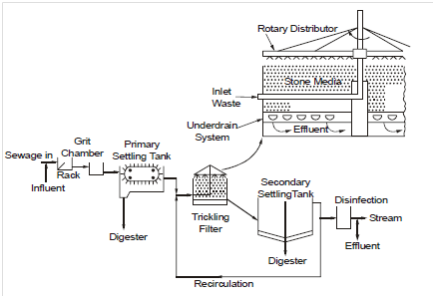Trickling Filters
The trickling filter is the most generally encountered aerobic attached-growth biological treatment procedure used for the removal of organic matter from wastewater. It consists of a bed of highly permeable medium to that organisms are attached, forming a biological slime layer, and by that wastewater is percolated. The filter medium commonly consists of rock or plastic packing material. The organic material present within the wastewater is degraded through adsorption onto the biological slime layer. In the outer portion of which layer, it is degraded through aerobic micro-organisms. Since the micro-organisms grow, a thickness of the slime layer raise and the oxygen is depleted before it has penetrated the full depth of the slime layer. An anaerobic environment is, therefore, established near the surface of the filter medium. As the slime layer increases in thickness, the organic matter is degraded before it reaches the micro-organisms near the surface of the medium. Deprived of their external organic source of nourishment, these micro-organisms die and are washed off through the flowing liquid. A new slime layer grows in their place. This phenomenon is referred to as 'sloughing'. After passing by the filter, the treated liquid is collected in an underdrain system, together along with any biological solids which have become detached from the medium (Figure 18). The collected liquid then passes to a settling tank while the solids are separated from the treated wastewater. A portion of the liquid collected within the underdrain system or the settled effluent is recycled to dilute the strength of the incoming wastewater and to manage the biological slime layer within moist condition.

Figure 18: Typical Flow Diagram for Trickling Filters